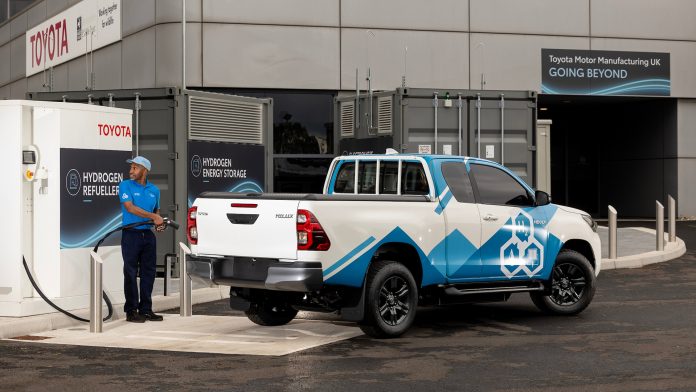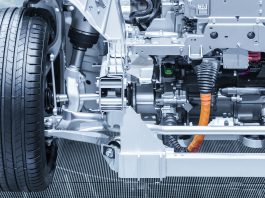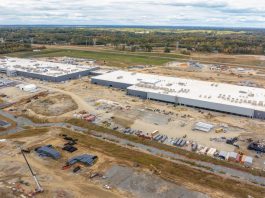Sunil Maher, Senior Project Delivery Lead, at the Advanced Propulsion Centre UK (APC), reflects on the development of a hydrogen fuel cell Toyota Hilux, and how it provides a tantalising glimpse into its future utility for zero tailpipe emissions light commercial vehicles.
The recent unveiling of the hydrogen-powered Toyota Hilux at Cenex-Low Carbon Vehicle & Cenex-Connected Automated Mobility 2023 has been hailed as a major breakthrough for the Light Duty Vehicle (LDV) and Light Commercial Vehicle (LCV) sectors.
Built on the chassis of the iconic Hilux, the new powertrain uses core elements from the Toyota Mirai hydrogen fuel cell electric saloon – technology that has proven its quality and reliability over almost ten years of commercial production. When driven, the fuel cell produces no tailpipe emissions other than pure water. A total of ten prototypes will be made for the project in Derbyshire, with some used as customer demonstrators and the remainder being used for static and dynamic testing to ensure the vehicle can meet the high standards required of a production model. If successful, it could open new possibilities for UK industry.
Helping car manufacturing reach net zero
The Toyota Hilux and similar vehicles of this type are used in a multitude of environments – both on-and off-road – and for a variety of applications such as people movement, utility-based services, and emergency response. This is a great alternative powertrain system for end-users and customers supporting wider initiatives of organisations to lower their environmental impact.
Nusrat Ghani, Minister for Industry and Economic Security, speaking about the ground-breaking vehicle, said: “We have an amazing manufacturing sector here in the UK, and this is another great example. It’s fantastic to see Toyota reach another milestone on their journey to zero emissions here in Britain, and I congratulate the project team for their success on this cutting-edge development.
“The UK is leading the way in next-generation car manufacturing, and this is yet another example of how the UK Government’s backing is helping our automotive industry lead the charge towards net zero.”
So just how will this achievement open up new possibilities for the industry, and how will it help to achieve the goal of decarbonisation?
The importance of the Toyota Hilux
Firstly, to understand why the development of this Toyota Hilux – which was funded by a £5.6m government grant deployed through the Advanced Propulsion Centre UK’s (APC) Collaborative Research and Development funding stream (£11.4m total project funding) – is so important it is prudent to look at how the industry is currently using Internal Combustion Engine (ICE)-led LCV and LDV units.
A Statista report predicts that the pick-up truck market will see revenues of $117.1m (approximately £94m) in 2023, with a growth rate of 1.58% by 2027.
Information provided by the Society of Motor Manufacturers and Traders (SMMT) showed that 22,205 new pick-ups have been sold so far in the UK in 2023. In total, there were 248,000 new light goods vehicle registrations in 2022, according to an S&P Global report.
The challenges of a hydrogen-powered pick-up truck
It is in the commercial sector that many of these registrations are taking place. Pick-up trucks are the backbone of many businesses that operate in rural areas. In the forestry industry, for example, pick-ups are used to traverse across vast and often uneven terrain, where getting to and from each location may take several hours while covering many hundreds of miles in a day.
Stopping to recharge a battery would eat into valuable working time and come with significant business costs. It is a similar situation in the mining industry, where charging an electric vehicle could happen on site at a quarry or mine, but given the logistics of such operations, would likely involve using a diesel-powered generator to provide the electricity needed by a Battery Electric Vehicle (BEV) charger. This would, of course, defeat the purpose of having a ‘green’ vehicle solution.
When we consider urban use, pick-ups and other LCVs that are used in the delivery and transport of tools and materials, trades such as the construction trade or horticultural services would also clearly benefit from a hydrogen-fuelled vehicle’s ability to quickly refuel on the go between jobs and further boosting productivity and profitability.
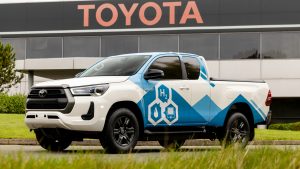
Competitive refuelling times
With this in mind, it is perhaps understandable that one of the most pressing questions posed by consumers using vehicles in this way is with regards to refuelling times. Currently, refilling the tank of a traditional petrol or diesel ICE vehicle can be done in a matter of minutes. Downtime for recharging a BEV presents somewhat of a planning conundrum for consumers that don’t have flexibility in their journey times, or businesses that need to be always on the road during working hours.
Hydrogen-fuelled vehicles much more closely rival ICE vehicles in this regard, with refuelling times measured typically to be under ten minutes, depending on tank size. The Toyota Hilux prototype for example, can refuel in under five minutes.
Richard Kenworthy, Managing Director of Toyota Motor Manufacturing UK, said: “What we’re looking at is a traditional Hilux, powered by an 80-kilowatt fuel cell, with seven kilograms of hydrogen storage, giving it a range of 350-400 miles. Most importantly, it can refuel in under five minutes.”
A commercially viable option
What the development of the Toyota Hilux shows then, is that there is technical capability to deliver all the utility of an ICE pick-up combined with all the green benefits of hydrogen in a commercially viable package. Coupled with the desire from industry, and commitment from government to provide the necessary infrastructure to keep them running on the road, and you have the framework for a real step-change in the light duty vehicle sector, which will start to rapidly develop over the next few years.
The APC forecasts rapid growth in fuel cell platforms for light duty vehicles from 2030, as hydrogen refuelling networks expand and hydrogen at the pump drops to $4-5/kg. As detailed in our report ‘Can the UK afford not to invest in hydrogen?’ we expect that 14GW of on-board fuel stack power and 400,000 hydrogen carbon fibre tanks will be required to meet the demands of Fuel Cell Electric Vehicle (FCEV) production in the UK alone by 2035. That’s the equivalent of 140,000 vehicles.
Costs can be driven down
The biggest barrier to widescale adoption of hydrogen fuel cell vehicles, however, is the current cost of producing the battery pack. A recent APC report “reducing the cost of fuel cells: how can it be done?” details that in order to achieve near parity with BEVs, hydrogen vehicles need to achieve a cost basis of $80 per kWh by 2030. Currently, it costs somewhere between $120-130 per kWh, assuming 94 kWh of useable energy in a light-duty FCEV.
Economies of scale are expected to be the main cost-down driver for the fuel cell stack and system. The APC report details how, at the production of 500,000 units at a single manufacturer location, costs could be driven as low as $86 kWh by 2030.
Performance improvements and material innovations are also expected to play a significant role in lowering $/kWh cost, which should help to bridge the remaining gap.
This means that fuel cell powertrains could be a cost-competitive complementary solution to batteries for some use cases, such as larger SUVs and vans, in the not-too-distant future.
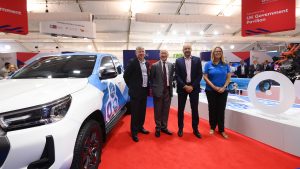
The next generation of the UK automotive industry
Ian Constance, APC Chief Executive Officer, speaking about the Toyota Hilux project, as well as the implications and future outlook for the UK as a destination for hydrogen fuel cell vehicle and component production, said:
“The Toyota Hilux project is a fantastic example of collaborative research and development (R&D) which has designed, integrated, and delivered a hydrogen fuel cell vehicle. UK government funding through the APC anchors capability in R&D, which helps safeguard and creates new jobs for the future. It embeds the next generation of net-zero vehicles and technologies in the UK.
“The project consortium has made significant progress to deliver several vehicle demonstrators developed and built in the UK. Seeing the prototype hydrogen fuel cell Toyota Hilux global launch within a year of the start of the project is a clear demonstration of the capabilities and strengths of the UK’s automotive supply chain.
“We already have 15% of the fuel cell value chain radiating from UK businesses, but this could be as much as 65% just by expanding on current strengths in electrochemistry and coatings or using our automotive capability to volume manufacture components like bipolar plates and stack assemblies.”
Conclusion
Demonstrating the capability of integrating a hydrogen fuel cell and associated technologies into a vehicle of this type is a significant leap forward and something that hasn’t been achieved previously. The collaborative nature of this APC-funded project and the approach to delivering an alternative powertrain solution provides another option for a wide customer base of this vehicle type.
This project has also shown that the UK is in a strong position in terms of engineering skills and supply chain resilience, providing benefits to the wider economy through further R&D investment, developing new skills, and job retention.
The UK’s journey towards net zero will require all vehicle types to use alternative powertrains. With vehicle manufacturers developing the technology and demonstrating integration into different vehicle platforms coupled with increasing demand from customers, the UK is in a strong position to deliver the required solutions and is leading the way in terms of engineering, design, manufacturing, supply chain, and skills.
Please note, this article will also appear in the sixteenth edition of our quarterly publication.

